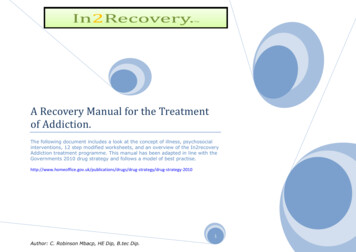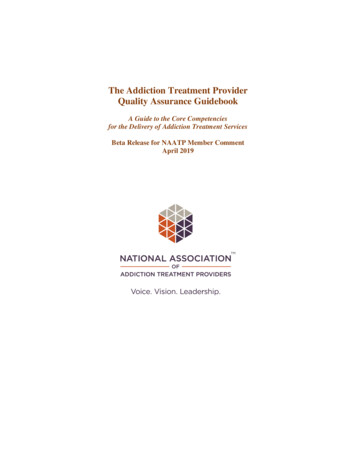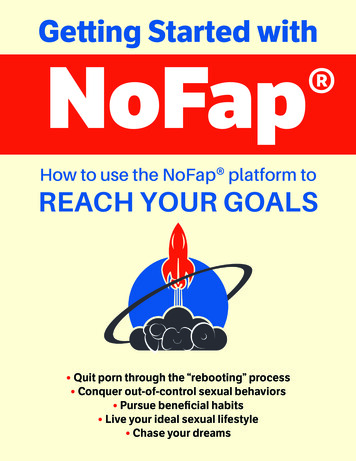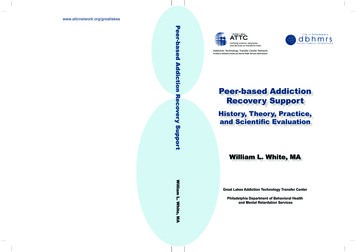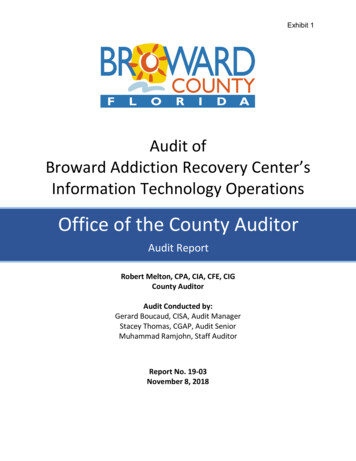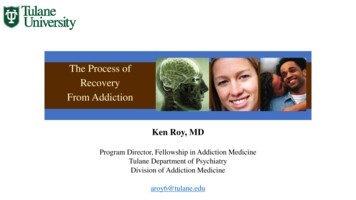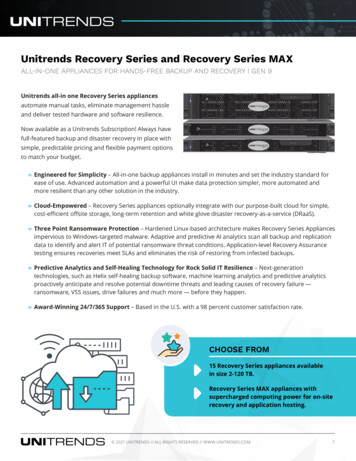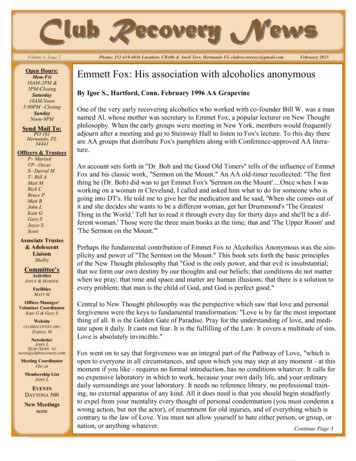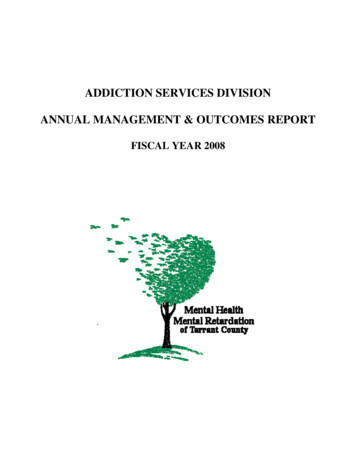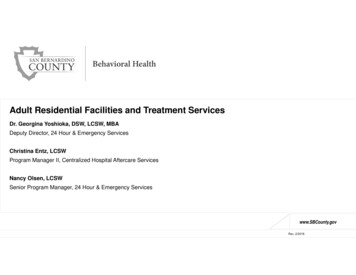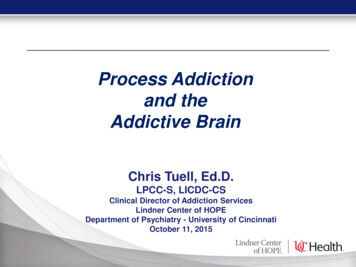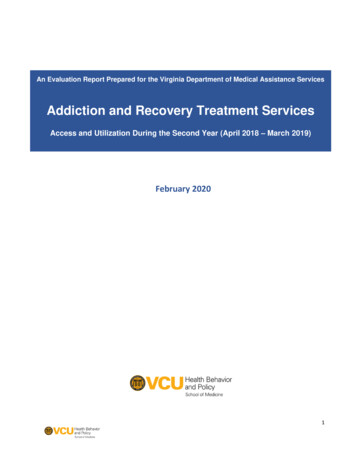
Transcription
An Evaluation Report Prepared for the Virginia Department of Medical Assistance ServicesAddiction and Recovery Treatment ServicesAccess and Utilization During the Second Year (April 2018 – March 2019)February 20201
Author Statement: This brief was prepared by Peter Cunningham, Ph.D., Megan Mueller, BA, and ErinBritton, MPH, at Virginia Commonwealth University, Department of Health Behavior and Policy. Othermembers of the ARTS evaluation team who contributed to this report include Heather Saunders, MSW, andAndrew Barnes, PhD.Acknowledgements: We would like to thank the Department of Medical Assistance Services for providingtechnical expertise on the Medicaid claims data and the ARTS program.Disclaimer: The conclusions in this report are those of the authors, and no official endorsement by theVirginia Commonwealth University School of Medicine or Virginia Department of Medical AssistanceServices is intended or should be inferred.2
TABLE OF CONTENTSExecutive Summary . . 4Introduction . 7Diagnosed Prevalence of Substance Use and Opioid Use Disorders. . . . . . 10Percentage of Members with Diagnosed Substance Use Disorders . . . . . . 12Co-occurrence of Substance Use Disorders with Other Physical and Mental Health Problems . . 13Members with Substance Use Disorders Enrolled Through Medicaid Expansion . 13The Supply of Addiction Treatment Providers After ARTS . . . 15Medicaid Members Treated for Substance Use Disorders . . 19Treatment Rates Continue to Increase in Year 2 of ARTS . . . . 22Pharmacotherapy for Treatment of Opioid Use Disorders . . . 24Quality of Treatment for Opioid Use Disorder . . . . . . 26Emergency Department Use Related to Substance Use Disorders . . . 26ARTS Service Use After Emergency Department Visits . . . . . . . 27Decrease in Acute Inpatient Admissions Related to Substance Use Disorders . . . . 28Services Received Following Discharge From Inpatient and Residential Treatment . . 29Decrease in Prescriptions for Opioid Pain Medications . . 31Conclusion . 313
Executive SummaryTo increase access to and quality of treatment and recovery services for Medicaid members with substanceuse disorders, Virginia implemented the Addiction and Recovery Treatment Services (ARTS) benefit in April2017. On January 1, 2019, Virginia expanded Medicaid eligibility for adults with family incomes up to 138percent of the federal poverty level, thereby increasing access to ARTS services and other Medicaid benefitsto more low-income Virginians.The Department of Medical Assistance Services (DMAS) contracted with Virginia Commonwealth UniversitySchool of Medicine to conduct an independent evaluation of the ARTS benefit. Prior evaluation reportsshowed large gains in access to and utilization of addiction treatment services among Medicaid members inthe year following implementation of ARTS, as well as decreases in emergency department visits and acuteinpatient stays related to substance use disorders.The objective of this report is to examine prevalence, treatment and utilization of substance use disordersamong Medicaid members during the second year post implementation of ARTS (April 1, 2018, throughMarch 31, 2019). The report examines changes in prevalence, treatment and utilization of ARTS servicescompared to the first year of ARTS, as well as the year prior to ARTS implementation. As the second year ofARTS coincides with Medicaid expansion, the report also provides estimates of the number of membersenrolled through Medicaid expansion diagnosed with substance use disorders, as well as differences incharacteristics of expansion members and other members with substance use disorders.The major findings of the report include the following:Diagnosed prevalence of substance use disorders There were more than 69,000 Medicaid members with a diagnosed substance use disorder during thesecond year of ARTS, including almost 30,000 with diagnosed opioid use disorder, and almost 24,000with diagnosed alcohol use disorder. Diagnosed prevalence of substance use disorders continued to increase among base Medicaid members,from almost 51,000 in the first year of ARTS to more than 57,000 in the second year of ARTS (12 percentincrease in prevalence between year 1 and 2 of ARTS). In the first three months of Medicaid expansion, 12,000 members with substance use disorder wereenrolled through the new eligibility rules.Supply of addiction treatment providers continues to increase During the second year of ARTS, more than 4,000 outpatient practitioners billed Medicaid for ARTSservices, continuing to increase since the beginning of ARTS. The number of Preferred Office-BasedOpioid Treatment programs has increased from 38 sites at the beginning of the ARTS program to 122sites by September 2019. The number of practitioners authorized to prescribe buprenorphine – the most widely used form ofpharmacotherapy for opioid use disorder – increased by 73 percent between 2016 and 2018. Twothirds of these prescribers either reported accepting new Medicaid patients, or had a paid Medicaidclaim in 2018.4
Treatment rates increase for substance use disorders Among base Medicaid members, treatment rates for substance use disorders increased from 40percent during the first year of ARTS to 49 percent during the second year of ARTS. Overall, treatmentrates for substance use disorders have more than doubled since the year before ARTS. Treatment rates for opioid use disorders (64 percent) are higher than for alcohol use disorders (44percent). However, there was a substantial increase in treatment rates for alcohol use disorders, from30 percent in the first year of ARTS to 44 percent in the second year of ARTS. By contrast, treatmentrates for opioid use disorder were largely unchanged in the second year of ARTS, after having increasedby 37 percent in the first year of ARTS.Pharmacotherapy treatment on the rise in the second year of ARTS Buprenorphine continues to be the most prevalent form of pharmacotherapy for members with opioiduse disorders, accounting for 58 percent of members who received any pharmacotherapy in the secondyear of ARTS. However, methadone treatment rates more than doubled, from 6 percent of members receivingmethadone treatment in the first year of ARTS to 15 percent of members in the second year of ARTS.Counseling and coordination with physical health and social needs increases Among members receiving buprenorphine treatment, the percentage who also received counseling orpsychotherapy for substance use disorders increased, from 61 percent in the first year of ARTS to 73 inthe second year of ARTS. More than three-fourths of members receiving buprenorphine treatment also received urine drugscreens, an increase from 53 percent in the first year of ARTS, and 35 percent in the year prior to ARTS. Almost half of members receiving buprenorphine are receiving case management or care coordinationservices, compared to only 18 percent in the first year of ARTS, and 4 percent in the year before ARTS.Greater utilization of short-term residential treatment More than 1,500 members used short-term residential treatment services (ASAM level 3) in the secondyear of ARTS, an increase from about 500 members who used such services in the first year of ARTS.The number of members using medically managed intensive inpatient services (ASAM level 4) increased34 percent between the first and second year of ARTS.Utilization of most other ARTS services increased substantially between the first and second year ofARTS, including Screening, Brief Intervention and Referral to Treatment (SBIRT) services (ASAM 0.5),peer recovery supports, and case management or care coordination services.5
Gaps remain following discharge from inpatient and residential treatment Within 30 days of discharge from a residential treatment facility, about half of members receivedservices at an intensive outpatient provider, partial hospitalization, Opioid Treatment Provider,Preferred Office-Based Opioid Treatment provider, or other outpatient treatment provider. One in fourmembers with opioid use disorder were receiving pharmacotherapy within one month of a dischargefrom inpatient detoxification. About one in six discharges from residential treatment resulted in readmission to the same level of careor higher within 30 days of discharge. The 30-day readmission rate for inpatient detoxification is 19percent.Acute emergency department use and inpatient hospital care use continues to decline Emergency department use and acute inpatient admissions related to substance use disorderscontinued to decrease in the second year of ARTS. Overall, emergency department utilization related toall substance use disorders has decreased by 7 percent since the year before ARTS, while emergencydepartment utilization related to opioid use disorder decreased by 32 percent in the same time period. The percentage of members with substance use disorders with an acute inpatient stay related to theircondition decreased from 31 percent in the first year of ARTS to 26 percent in the second year of ARTS.For members with opioid use disorders, the percentage with an inpatient admission related to theircondition decreased from 21 percent to 16 percent during the same time period. About one in three members (32 percent) with an emergency department visit for opioid use disordersreceived some type of ARTS service within seven days after the visit, and 47 percent received some typeof treatment within 30 days of the visit.Prescribing for opioid pain medications continues to decrease The number of members receiving prescriptions for opioid pain medications continued to decline, from115,000 members in the first year of ARTS to 94,000 base Medicaid members in the second year.Overall, the number of prescriptions for opioid pain medications has decreased by 29 percent since theyear before ARTS, while the number of members receiving such prescriptions decreased by 32 percent.In sum, most of the gains in access to and use of substance use disorder treatment services observed in thefirst year of the ARTS program continued in the second year. Moreover, continued decreases in emergencydepartment use and acute hospital utilization for substance use disorders during the second year of ARTSsuggest that the increase in access to services is contributing to improved outcomes. Despite substantialevidence of improved access to addiction treatment services through the ARTS program, some gaps remain.Treatment rates for alcohol use disorders – although considerably higher than before ARTS – are lower thantreatment rates for opioid use disorders. Disparities in diagnosed prevalence and treatment of substanceuse disorders by race/ethnicity treatment rates are of particular concern. In addition, lack of follow-uptreatment following discharges from inpatient detoxification and short-term residential facilities mayincrease the risk of relapse and readmissions to these facilities. Assessing the impact of transitions along thecontinuum of treatment services on outcomes of treatment is a key goal for future evaluation of the ARTSprogram.6
IntroductionSubstance use disorders – including dependence on or misuse of alcohol and other legal and illegal drugs –continues to be a major public health concern in the Commonwealth of Virginia, as it is for the U.S. overall.The number of fatal drug overdoses more than doubled in Virginia between 2007 and 2017, from 721fatalities in 2007 to 1,526 in 2017.1 After decreasing by 3 percent in 2018, the Virginia Department of Healthreported an uptick in fatal drug overdoses during the first quarter of 2019.2 More than 80 percent of fataldrug overdoses in 2018 were due to prescription or illicit opioids, with heroin and fentanyl driving theincrease in fatalities in recent years. While national and state efforts often focus on opioid use disorders,fatal overdoses due to cocaine and methamphetamines have also risen sharply in Virginia in recent years.Aside from overdose fatalities, substance use disorders exact a much broader human and societal cost,affecting the economic and social well-being of families and entire communities, as well as people’s abilityto lead productive and fulfilling lives.3 The National Institute of Drug Abuse estimated the annual nationalcosts associated with misuse of alcohol, illicit drugs, and prescription drugs to be 520 billion, reflecting lostwages, foregone economic opportunities, and private and public sector spending to prevent and controlsubstance use.4 Social costs associated with substance use disorders include family breakup and otherdeclines in family and personal well-being, increased involvement with the criminal justice system, andplacement of children of parents with severe disorders in social services and foster care.5Both nationally and in Virginia, Medicaid is more likely to cover members with substance use disorderscompared to private insurance. In Virginia, Medicaid members are more than twice as likely to reportdependence or misuse of alcohol or illicit drugs (13 percent) compared to people with private insurance (6percent).6 Also, Virginia Medicaid members are 2.75 times more likely to report dependence or misuse ofopioids compared to Virginians with private insurance.To increase access to substance use treatment services for Virginia Medicaid members, the Addiction andRecovery Treatment Services (ARTS) benefit was implemented in April 2017. ARTS expanded coverage ofmany addiction treatment services for Medicaid members, including community-based services, short-termresidential treatment and inpatient detoxification services. To allow federal Medicaid payment for addictiontreatment services provided in inpatient and short-term residential facilities, a Section 1115 DemonstrationWaiver for substance use disorders was approved in December 2016 by the Centers for Medicare andMedicaid Services (CMS). ARTS also increased provider reimbursement rates for many existing services, andintroduced a new care delivery model, the Preferred Office-Based Opioid Treatment (OBOT) provider, whichintegrated medications for opioid use disorder with behavioral and physical health by incentivizing increaseduse of care coordination activities. To further increase integration of addiction treatment services withother health services covered by Medicaid, substance use disorder services are administered by the sixmanaged care organizations that manage medical and behavioral health benefits for all Medicaid members,offering a comprehensive care delivery system.On January 1, 2019, Virginia expanded Medicaid eligibility for adults ages 19-64 with family incomes up to138 percent of the federal poverty level. As of November 2019, more than 340,000 low-income Virginianswere newly enrolled through Medicaid expansion.7 Medicaid expansion increases access to ARTS servicesfor many low-income adults who had substance use disorders prior to enrolling in Medicaid. Prior toMedicaid expansion, prevalence of substance use disorders among the uninsured in Virginia (18 percent)was higher than for Medicaid members (13 percent).8 Among Virginians who reported dependence ormisuse of opioids prior to Medicaid expansion, more than half were uninsured.7
Objectives of the reportThe Department of Medical Assistance Services contracted with Virginia Commonwealth University Schoolof Medicine to conduct an independent evaluation of the ARTS benefit. The evaluation is conducted byfaculty and staff from the Department of Health Behavior and Policy, and the Department of FamilyMedicine and Population Health.This report examines substance use treatment prevalence, access and utilization among Virginia Medicaidmembers during the second year of the ARTS benefit, corresponding to the period April 2018 through March2019. This report updates and expands on a prior report that examined changes in access to and utilizationof ARTS services in the year following implementation of ARTS.9The findings from the evaluation of the first year of the ARTS benefit showed substantial gains in thenumber of addiction treatment providers serving the Medicaid population, as well as large increases in thepercentage of members with substance use disorders receiving various types of treatment, includingmedications for opioid use disorder. Moreover, there were significant decreases in hospital emergencydepartment and acute inpatient use for members with substance use disorders after ARTS relative to otherMedicaid members, suggesting improved access to care.10 In addition to increased access to treatmentservices through ARTS, substantial declines in opioid prescribing in Medicaid may have also contributed toimproved outcomes among Medicaid members.11This report shows that many of the gains in access to and use of substance use disorder treatment servicescontinued in the second year of ARTS. As the second year of ARTS overlaps with the first three months ofMedicaid expansion, the report also examines prevalence of substance use disorders among the Medicaidexpansion population between January and March 2019, and how the characteristics of those withsubstance use disorders differ between the Medicaid expansion population and other adults enrolledthrough traditional eligibility criteria.How the analysis was conductedThe findings in this report are based primarily on an analysis of Medicaid paid claims from the Departmentof Medical Assistance Services (DMAS). For most estimates of diagnosed prevalence, treatment, andutilization of services, we compare estimates of paid claims during the second year of ARTS (April 1, 2018through March 31, 2019) to the same 12-month period during the first year of ARTS (April 1, 2017, throughMarch 31, 2018) and the year preceding ARTS implementation (April 1, 2016, through March 31, 2017).These estimates exclude claims for services during the study period that had not yet been submitted or paidat the time of the analysis, unpaid claims and services not covered by Medicaid.As mentioned previously, a major policy change during the second year of ARTS was expanding eligibility forMedicaid coverage, beginning January 2019. Due to Medicaid expansion, there were about 274,000additional Medicaid members enrolled between January and March 2019, which also affects the number ofmembers diagnosed and treated for substance use disorders during the second year of ARTS. In addition,members with substance use disorders enrolled through Medicaid expansion may differ from othermembers with substance use disorders in ways that affect their utilization of services, such as differences inage, gender, race/ethnicity and health status.The report includes members newly enrolled in Medicaid expansion in estimates of the number of memberswith diagnosed substance use disorders and who used various treatment services during the second year of8
ARTS. However, to ensure comparability with the years prior to Medicaid expansion, analyses that showchanges in rates of utilization and treatment between the second year of ARTS and earlier years include onlythe base Medicaid population, that is, members enrolled in Medicaid through traditional eligibility criteria.For these analyses, we also include members enrolled through the Governor’s Access Plan (GAP), eventhough most of these members were transitioned to full Medicaid coverage by March 2019. Prior toMedicaid expansion, GAP provided coverage for ARTS and other behavioral health services to people whodid not qualify for full Medicaid benefits.9
Diagnosed Prev
2 Author Statement: This brief was prepared by Peter Cunningham, Ph.D., Megan Mueller, BA, and Erin Britton, MPH, at Virginia Commonwealth University, Department of Health Behavior and Policy. Other
